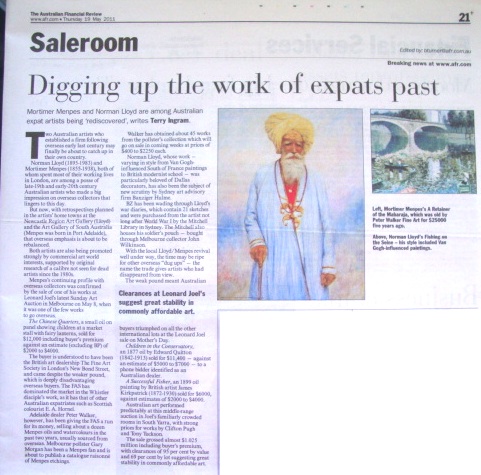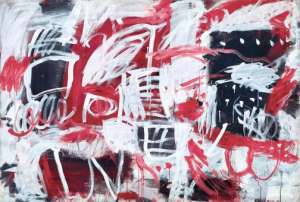By Susan Muldowny, published in “In The Black”, 27 October 2015
Looking for an alternative form of investment? Fine art can bring great rewards, but you need to do your homework and seek advice.

When Grace Cossington Smith’s modernist painting The Window sold for double its pre-sale estimate at a Sotheby’s Australia auction in November 2014, the local art world was aghast. Not only did this mark a record price for the late artist’s work, it also signalled a long-awaited lift in the Australian art market. While the A$671,000 final bid for The Window may be out of reach for most budding art investors, it suggests that art can indeed stack up as an alternative form of investment. But identifying up-and-coming artists takes more than scanning local auction records. You need a good knowledge of the art market and you must enjoy the thrill of a chase.
Marking a return
Art investment has an emotional quality that few can ascribe to the stock market. It can also make good financial sense.
Researchers from Griffith University investigated the financial returns for the works of 45 well-known Australian artists sold at auction between 1973 and 2003. They found the average annual returns across all artists ranged between 4 and 15 per cent, with a mean of 8 per cent. The highest returns were for works by Brett Whiteley, Jeffrey Smart, Cecil Brack and Margaret Olley.
Much has happened in the art world since this time. Like all investments, art is subject to changing market conditions. The global financial crisis had a significant impact on auction sales.
The average art returns in Australia declined in nominal terms by close to 6 per cent from 2008–2009. Today, the market is creeping back. Auction houses made A$94 million in combined takings in 2014, up A$10 million from the year before.
Getting started
While any budding art investor should start with a solid understanding of the market, David Hulme, director at Banziger Hulme Fine Art Consultants and president of the Art Consulting Association of Australia, says many investors jump the gun.
“You need to consider things [like] the condition of the artwork and whether it’s a good representation of the artist’s work,” he says.
“You need to get down to the nitty-gritty. It’s not just about saying ‘Oh, this is fabulous’. Emotion is critical, but you need the other things to back it up or it can fall apart very quickly.”
Hulme suggests visiting galleries and art fairs and engaging an independent art consultant for advice. He stresses that art will not bring financial returns overnight.
“You need to keep it for as long as possible – 10 or 20 years is not a bad idea,” he says.
“It’s very different to other types of investment. My view is that if art is valued at at least 80 per cent of its purchase price, it’s liquid.”
Primary versus secondary markets
An artwork’s first sale through a gallery is considered its primary market; however, it is in the auction room – the secondary market – where a work’s true value is usually determined.
“In the secondary market, the estimates are usually below gallery levels, especially for young artists, because they’re having to be tested on the art market,” explains Sophie Ullin, head of art at Leonard Joel auction house.
Ullin says art is subject to the cycles of fashion, which can influence its value.
“Taste is a hard thing to harness and define, but you do get trends,” she says.
“Gum tree art, like the landscapes of the turn of the century with a swagman, are no longer popular. A 35-year-old is not going to relate to that idea of Australia or the world.”
Ullin suggests considering future trends when buying art for investment. “You’ve got to think about what drives younger people,” she says. “I’d be looking at urban street art for the future.
“The majority of collectors in the next 20 years aren’t going to be looking at Jeffrey Smart or Charles Blackman. They’ll like the work, but it’s already too high and it’s not the art that they will necessarily relate to.”
The bigger picture
Tom Lowenstein FCPA is the director of Lowenstein’s Arts Management, which specialises in providing taxation and business services to clients in the field of visual arts. Although his personal art collection includes works by some of Australia’s most revered artists, he had very little interest in art before his wife developed a love of it several decades ago.
“Not everybody is born with the ability to look at something and say ‘this is great’. It’s more about education and exposure,” he says.
Lowenstein says well-established galleries usually represent artists with investment potential. Major international solo exhibitions and high-profile commissions are also a good indication of future value.
“Artists such as Michael Zavros or Ben Quilty are coming to the fore in great demand,” he notes. “[Artists like Quilty have] done stints as war artists, and that’s recognition of their importance.”
Looking at the risks
Art for investment is most commonly bought in the traditional primary or secondary markets but there is a growing popularity for online purchases through galleries such as Saatchi Art or through websites such as Artsy, which allows artists to sell their work direct to the public.
“It’s certainly empowering for artists,” says Hulme, “but it’s also a complete needle in a haystack. Whether you’re going to discover the next big artist is unknown.”
Lowenstein agrees that art investment comes with financial risks.
“You may have 100 starters and only two of them will make a name for themselves, and I think generally you’ve got to live with that,” he says.
“Provided you get proper advice and you have some sort of investment strategy that is developed in conjunction with an art consultant, you can build up a major collection. There are a number of people who have made much better returns on their art than they have on the stock exchange.”
Artists to watch
For less than A$10,000, Hulme suggests a painting by Paul Ryan could be a wise investment. A regular Archibald Prize finalist, Ryan’s work is divided between portraiture and landscapes as well as subversive explorations of Australia’s colonial history.
If you have a spare A$10,000 to invest in art, Hulme recommends looking at the work of Guy Maestri, who won the Archibald Prize in 2009 for this portrait of Geoffrey Gurrumul Yunupingu.
For the same price, Ullin would put her money on Hiromi Tango.
“She creates three-dimensional work that would appeal to younger collectors. Her works are wild.”
For a more significant investment of A$50,000, Ullin would back Brook Andrew, an Indigenous artist working with neon, installation and mixed media. Hulme says the work of Ben Quilty would be a wise investment for a similar amount.
“We’re going to see more great things from this artist.”
Reference: In the Black




